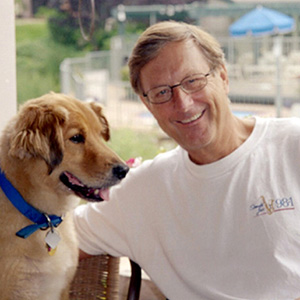
Denny Braun and Sonny, his rescued golden retriever.
Education reform, nature-deficit disorder, Eisenhower’s presidency, and conspiracy in the processed food industry are just some of the intriguing topics discussed in the nonfiction Book Club of the Osher Lifelong Learning Institute at SDSU. And facilitating them is Denny Braun, Ph.D., a professor emeritus of sociology. Braun spent a year as a demographer/statistician at the U.S. Census Bureau in Washington, DC before joining the faculty at Minnesota State University, Mankato where he taught “Courtship, Marriage, and Family” for over 20 years.
When he retired in 2002 and moved to San Diego, his affiliation with the Osher Institute began as a student a few years later. The slew of courses he’s taken includes the archeology of Jamestown and San Diego, the historical influence of religion in America, and the sociological importance of various Star Trek series on television.
“One of the best parts about being an Osher student is that there are no tests or required readings,” said Braun. “Our classroom experience revolves around the pure joy of learning for learning’s sake.”
His joy of learning reignited his joy of teaching, and when Braun saw a need for sociological courses at the Osher Institute, he made it happen. His lectures have included The Changing American Family, and Growing Income Inequality in the United States. Braun’s passion for the topic of social injustice runs deep.
When did you first become interested in human social behavior?
I was raised in Rochester, Minn.—home of the Mayo Clinic. In high school, there was a huge social chasm between the doctors’ kids and the rest of us. In addition, I was from a very poor family. This burning sense of social injustice caused by an apartheid social class system fed my desire to understand and explain why this was so. By the time I entered college and encountered sociology, I embraced my chosen field of specialization: social stratification. During my career, I further narrowed this to the study of income inequality, publishing two editions of my book, “The Rich Get Richer.”
When and why did you relocate to San Diego?
I came in 2002. Having spent nearly my entire life in Minnesota, enduring its brutal winters, Hotel California beckoned without mercy! And once here, the experience of California living totally intoxicates a person. The Eagles were right in their song: “You can check out any time you like, but you can never leave!” (Meaning, it stays with you and beckons you back even if you foolishly move to another state.)
How did you first learn about the Osher Lifelong Learning Institute and how did you become involved?
I received a catalog in the mail for SDSU Osher once I moved here. By then, I was several years into retirement and realized I needed more of the intellectual environment I had taken for granted as a professor on campus, so I signed up.
You were first an Osher Institute student, then an instructor. How did that come about?
Although I do feel I have received an intellectual experience taking courses, I missed teaching. I also realized there was room for sociological courses at SDSU Osher. There is also a heavy component of scholarly preparation and challenge when you prep for teaching courses, and I had missed the intensity, focus, creativity, and challenge of that experience as well. Lastly, I must have an “educator” gene in my DNA, as do other Osher people (many are former teachers). I cannot LEARN something, and then not want to SHARE it with others.
What’s the best part of being an Osher Institute student?
Knowing and interacting with the other students—we are, at bottom, a social community.
Given the meaty subject matter of Osher Nonfiction Book Club books—such as 2013’s “The Price of Inequality: How Today’s Divided Society Endangers Our Future” (Joseph E. Stiglitz), and the upcoming (July 15, 2014) “The End of Men, The Rise of Women” (Hannah Rosin)—how do you discuss a book in an hour and a half, especially given the cross-section of humanity that can be found in any Osher classroom?
Actually, it becomes a delightful journey because I am “given the cross-section of humanity that can be found in any Osher classroom.” In essence, Osher students are taking courses because they have a love of learning. They want to be there, they want knowledge, they want to discuss the subject matter, they are curious, alive, and vital. In short, they are the type of people I really want to be around in my own retirement—because they inspire me, challenge me, feed me insights, support me in my interests, and—in many cases—make me laugh! And, as you probably have observed already, Osher students are not shy about sharing their experiences and viewpoints. Nearly always, their contributions are insightful and deeply meaningful.
Why do you think students come back again and again for courses, lectures, book clubs and other Osher Institute offerings?
I believe we all have in common the same hunger for learning and knowledge, to make our lives more fulfilling and interesting. Plus, we really are a community in the best sense of the word!
Do you have a fun or favorite Osher Institute anecdote?
At one point we ended up having a spirited discussion on Big Tent (our online learning platform) during John Putman’s history class covering the 1950s on what was the best sports car of that decade. They started coming out in 1954. Of course, the T-Bird and Corvette were two of the first, but I actually posted a picture and description of Studebaker’s Golden Hawk. They were all stellar cars at that point—sexy, fun, connoting freedom and the open road for our newly emerging interstate highway system (thank you, Ike). Maybe this interest was just “a guy thing”—but it ignited the passion I felt when I was a kid eating my Wheaties and I pulled a toy replica of these cars out of the breakfast cereal box. For me, it brought back what was really GOOD about that era (there was plenty of bad as well, but that’s another story).
Can you tell us more about the online Big Tent discussion exchange?
Big Tent is a great place to post supplementary material, especially news articles that are germane to the course. This fall, when I teach Public Opinion and the Mid-term Elections, I hope to persuade many in the class to sign up so we can discuss the issues online as they unfold in the month prior to the election.
(Hosted on BigTent.com, Big Tent is an optional tool where Osher students and instructors can communicate outside the classroom.)
How has teaching Osher Institute students inspired you personally?
Many of our students are concerned with contemporary societal trends and social issues (politics, economics, changing family, demographic shifts, etc.), so we have vital and meaningful discussions about current affairs and—to some degree—history as well. They keep me alive, and instill a sharp desire in me to put material together for them to share in the classroom.
What would students be surprised to know about you (aside from the fact that you make beautiful, award-winning pottery that can be seen at dennybraun.com)?
Thanks for the pottery compliment! I am on a Buddhist spiritual path, and that has led me to travel extensively in Asia (China, Tibet, Cambodia, Thailand, Burma, Laos, and Vietnam). I absolutely LOVE that part of the world, because I have encountered people with so little in material possessions, but with hearts as big as mountains! They have suffered much, not only from the Vietnam War (in their country, they call it “the American War”), but wars with China, the horrifying genocide of Pol Pot in Cambodia, despotic generals ruling in Burma for two-thirds of a century, brutal Japanese occupation during WW II. Yet, their spirit is undiminished. I am awe-struck by their resilience, their love for family and community, their humor, and the simplicity with which they embrace life. They inspire me! So, yes, travel would be a passion with me—and I would recommend Burma as the number-one destination (you can always see Paris or Italy later). Burma is opening itself to the world for the first time since 1946, and there is a growing, fragile democracy that is beginning to take root in their country. But if one wants to see what SE Asia looked like just after WWII, go to Burma now. It is a time capsule that exists nowhere else on earth.
Anything you’d like to add that I didn’t ask?
An added benefit to the Osher Institute is being on campus with students in their 20s. There is an energy and exuberance on university campuses that I have sorely missed. For Osher participants, it can be a nice generational mix, especially when we can get to interact with them on a volunteer basis. It would be nice if a few could visit our classes as well, see if they could gain something from our experiences over a lifetime. I know we could gain insights from them also, into what’s happening within the millennial generation.



